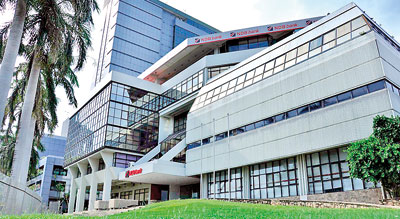Banking
S&P assigns NDB International Rating of B+/B
View(s):Same level as the Sovereign Rating on Sri Lanka
On June 26, 2013, Standard & Poor’s (S&P) Ratings Services assigned its ‘B+’long-term and ‘B’ short-term counterparty credit ratings to Sri Lanka’sNational Development Bank PLC (NDB). The outlook on the long-term rating isstable. The Bank’s standalone credit rating profile (SACP) is’b+’ and is atthe same level as the sovereign rating on Sri Lanka (B+/Stable/B).
Standard & Poor’s bases its ratings on NDB’s “adequate” business position,”moderate” capital and earnings, “adequate” risk position, “below average”funding and “adequate” liquidity, as defined under its criteria. NDB’s “adequate” business position reflects S&Ps view of the bank’ssatisfactory business and revenue diversification and the fact that NDB is awell-managed bank compared with peers in emerging markets.

NDB is theninth-largest bank in Sri Lanka with total assets of about 193 billionRupeess as of Dec. 31, 2012. The bank’s deposit market share isabout 3% of the entire banking industry. Like that of most other Sri Lankanbanks, the majority of NDB’s loans emanate from Sri Lanka. Nevertheless, thebank provides a full range of banking services and operates on a universalbanking platform. NDB’s principal activities are commercial banking,development financing, merchant banking, investment banking, venture capital,stock broking, wealth management, property investment and insurance. NDB’srevenue base is stable and diversified. Fee income has been about 17% of netrevenue for the past five years.
S&P has recognized the bank’s capital and earnings as “moderate” based on the expectation thatthe pre-diversification risk-adjusted capital (RAC) ratio will fall into themoderate category in the next two years. The ratio is 8% as of Dec. 31, 2012.
S&P notes that NDB’s earnings profile is better than the industry with return on averageassets averaging about 2% over the past five years. The bank’s good revenuediversity and low provisioning cost characterize its earnings profile. In itsview, NDB’s profitability could decline somewhat in 2013 because S&P expects thebank’s margin to fall and its credit costs to rise. Moreover, in view of thebank’s high loan growth of about 20%, its retained earnings are not likely tobe sufficient to support the RAC ratio at its current level. S&P expects the RACratio to decline to about 6.5% in the next two years.
S&P viewsNDB’s risk position as “adequate,” reflecting the bank’s adequate riskmanagement practices for its size and scale, and its good loan lossexperience. NDB’s credit costs have been lower than the industry average. Inthe past eight years, the bank’s peak credit cost (as a percentage of averageassets) was about 31 basis points in 2009, compared with the industry averageof 93 basis points. In it’s report S&P states ‘while we expect the bank’s credit costs to rise because ofportfolio seasoning, they are likely to remain better than that of peers. Thatsaid, some degree of industry concentration exists, such as an exposure to thetextile and garments industry, which increases NDB’s vulnerability’.
In S&Ps view,NDB’s funding iscategorized as “below average” and its liquidity as “adequate,”reflective of the bank’s smaller branch network. The report notes that NDB’s funding profilehas improved over time, but it still remains weaker than other large bankingpeers. Core deposits form about 75% of the bank’s funding base as of Dec. 31,2012, but the ratio is still somewhat lower than the industry average. Thebank’s ratio of customer loans to customer deposits, at 110%, is still higherthan most other peers’, although the ratio has improved considerably from 200%in 2007. The proportion of low-cost current and savings accounts (CASA) isalso comparatively low, at 24%. S&P expectsNDB’s funding profile to improvefurther, albeit at a slower pace.
The bank’s sizable holdings of governmentbonds and central bank balances underpin its liquidity.The issuer credit rating on NDB is the same as the SACP. S&P further assesses that thereis a “moderate” likelihood that the government would provide timely andsufficient extraordinary support to NDB in the event of financial distress,because of the bank’s “moderate systemic importance,” given its size in SriLanka and its assessment of the government as “supportive.”
S&P’s bank criteria use its Banking Industry Country Risk Assessment (BICRA) economic risk and industry risk scores to determine a bank’s anchor SACP, the starting point in assigning an issuer credit rating. S&Ps anchor SACP for a commercial bank operating only in Sri Lanka is ‘bb-’. The BICRA score is based on S&Ps evaluation of economic risk, where Sri Lanka is viewed as a low-income economy. S&P believes economic imbalances have started to build up in Sri Lanka with the pickup in private sector credit growth; further stating that high loan growth, coupled with rising competition; a slow foreclosure process except for mortgages and hire purchase and evolving risk management practices could increase credit risk.
S&P report further states that a large proportion of highly stable core customer deposits support Sri Lanka’s industry profile. Accordingly S&P views the banking regulations in Sri Lanka as somewhat weaker than international standards; nevertheless, noting that the banking regulations and supervision are improving and the regulator has an adequate record of managing the financial sector.
Outlook
The stable outlook reflects S&P’s view that NDB will maintain its financialprofile over the next 12 months, despite a slight weakening in its assetquality and capitalization.
S&P states that they could downgrade NDB if the sovereign rating is lowered or the bank’s SACPdeteriorates, which could happen if NDB’s asset quality weakens substantiallyleading to a considerable increase in credit costs.
S&P further notes that it could upgrade NDB if the sovereign is upgraded, provided that the bank’sSACP improves. An improvement in NDB’s funding profile to levels in line withthe industry could result in a better SACP–a scenario that S&P views asunlikely in the near term.
Follow @timesonlinelk
comments powered by Disqus

